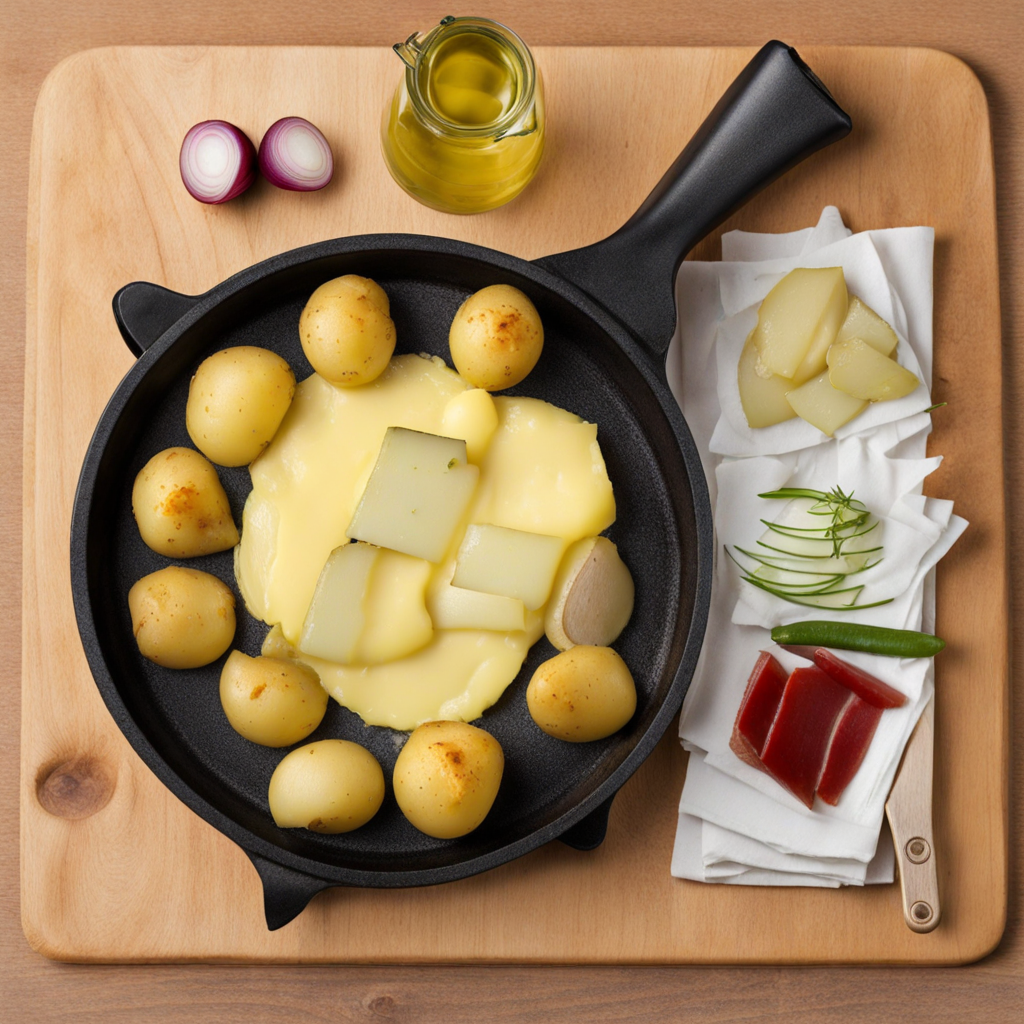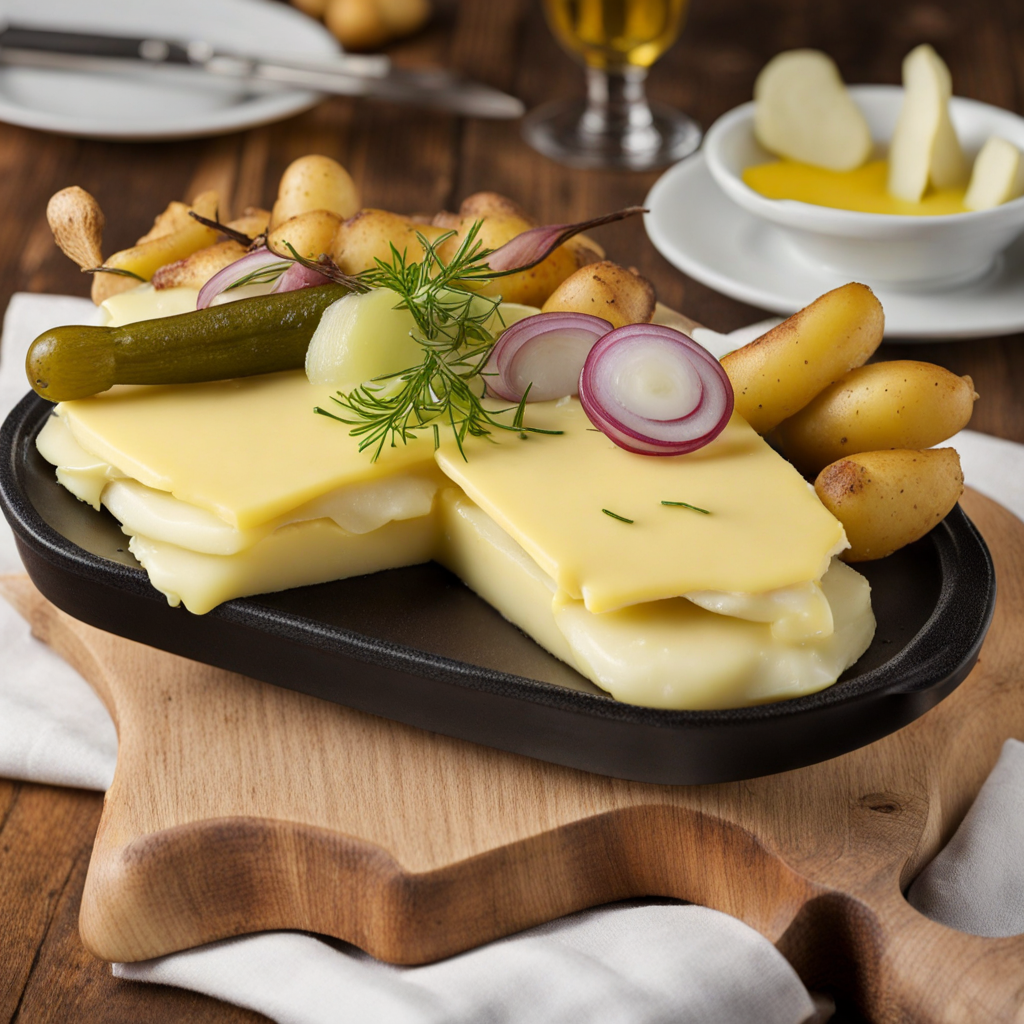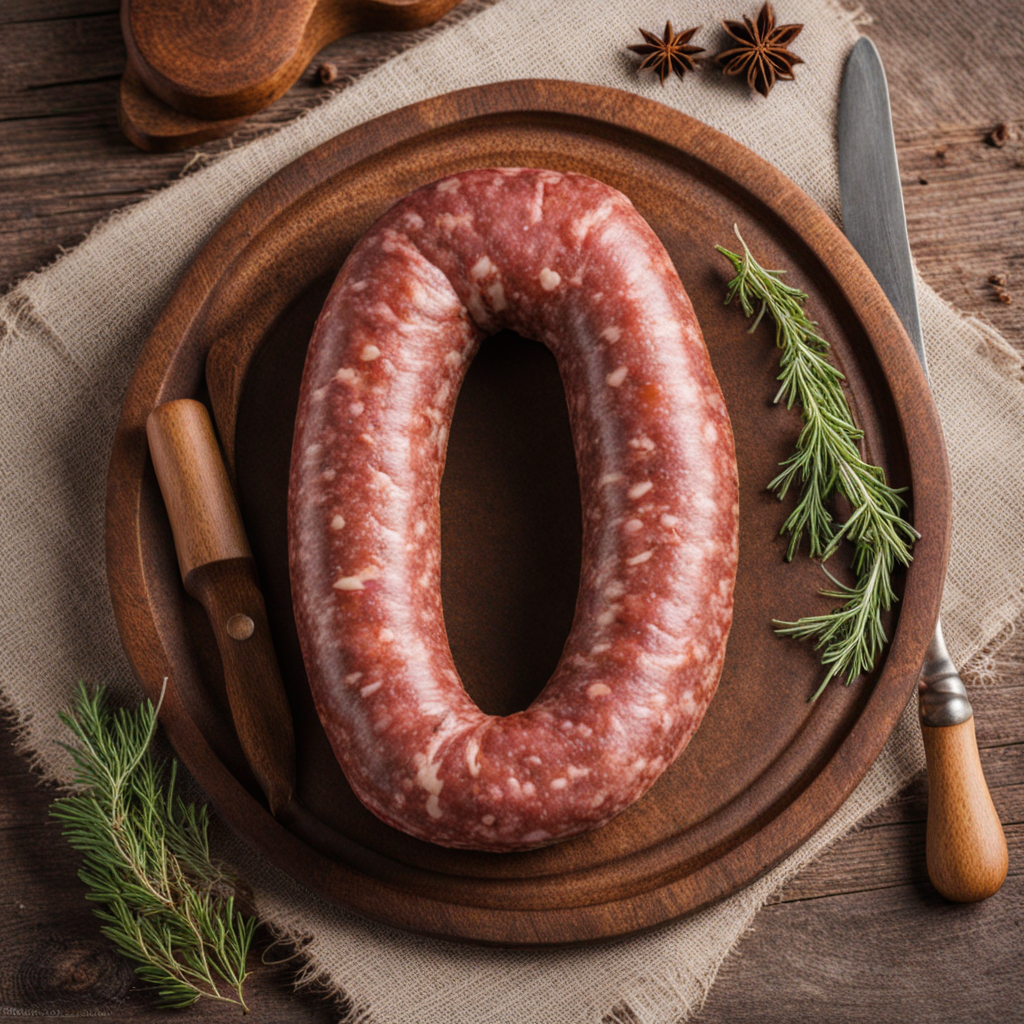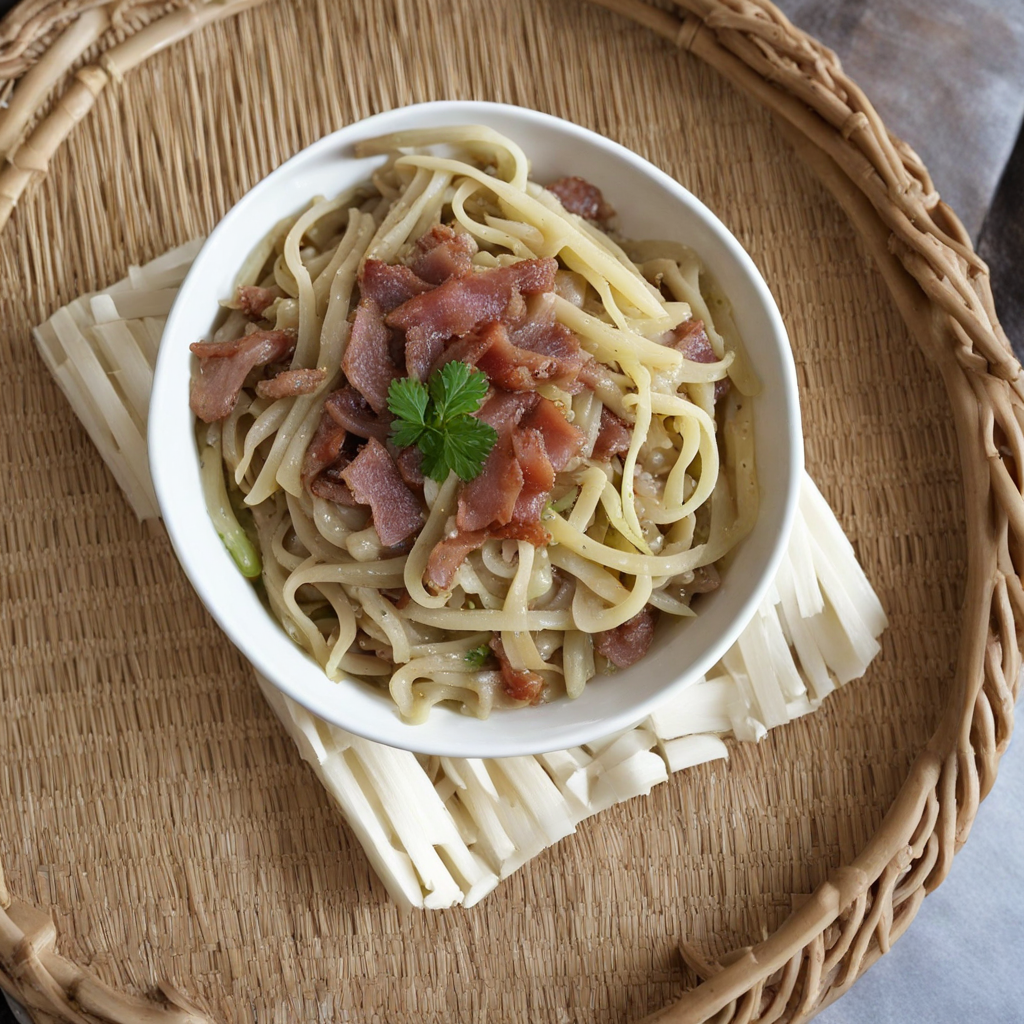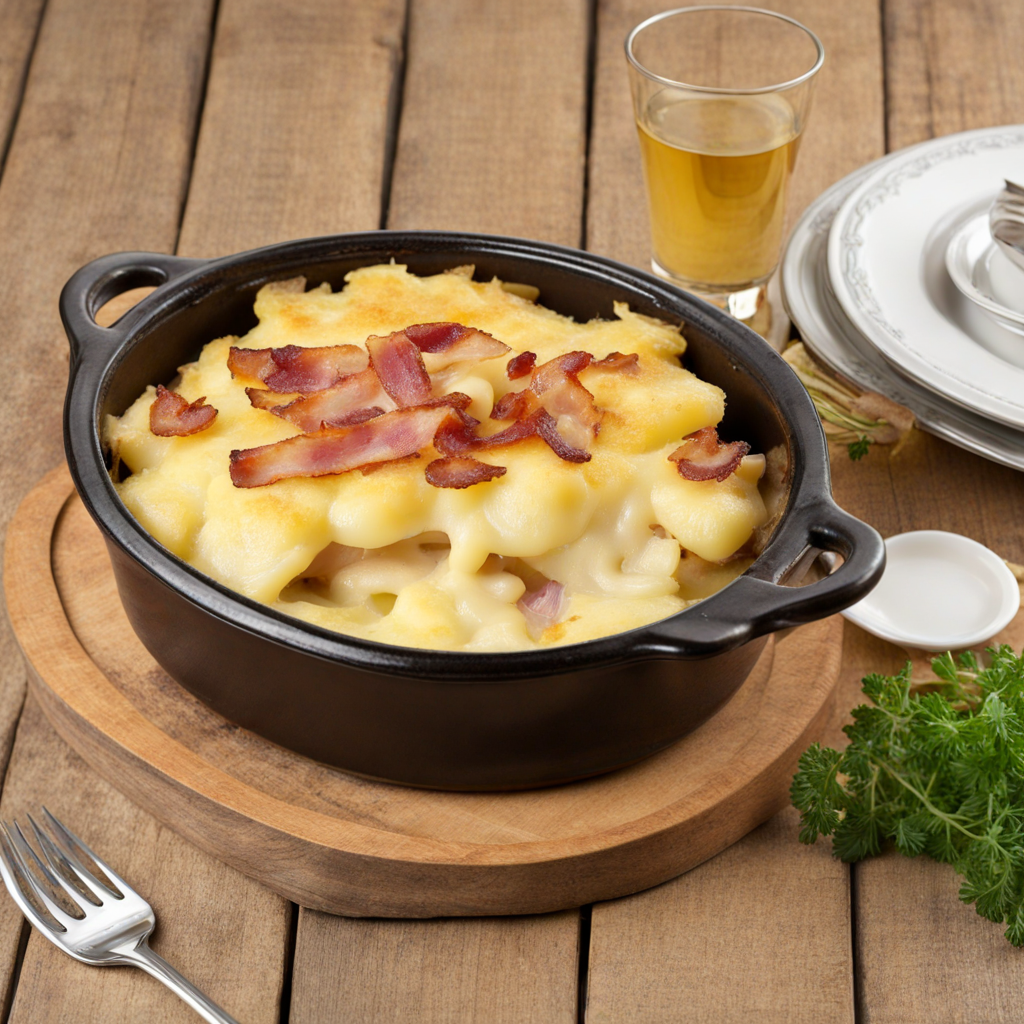Raclette
Raclette is a traditional Swiss dish that revolves around the star ingredient of the same name: a semi-hard cheese that is known for its creamy texture and rich, nutty flavor. Originating from the Alpine regions of Switzerland, Raclette cheese is typically melted and scraped off the wheel, creating a delightful and indulgent experience. The process of melting the cheese is often done using a special grill or raclette machine, where the cheese is heated until it becomes gooey and luscious, making it the perfect accompaniment for a variety of sides. When served, Raclette is usually paired with boiled or roasted potatoes, pickles, and cured meats, which enhance the cheese’s flavor profile. The combination of the warm, melty cheese with the starchy potatoes creates a comforting and satisfying bite, while the tang of pickles and the richness of the meats add layers of taste and texture. This symphony of flavors makes every bite a delightful experience, inviting you to savor the simplicity and rustic charm of Swiss cuisine. Raclette is not just a dish; it embodies the spirit of sharing and socializing, often enjoyed in a communal setting where everyone can gather around the grill, melting their cheese to their liking. The ritual of scraping melted cheese over your chosen accompaniments fosters a sense of togetherness, making it a perfect choice for gatherings and celebrations. With its heartwarming flavors and interactive dining experience, Raclette offers a unique taste of Switzerland that is sure to captivate anyone looking to explore new culinary delights.
How It Became This Dish
## The History of Raclette: A Culinary Tradition from Switzerland Origins of Raclette The roots of Raclette trace back to the Swiss Alps, particularly the Valais region, where it has been enjoyed for centuries. The name "Raclette" derives from the French word "racler," meaning "to scrape," a reference to the traditional way the cheese is served. This semi-hard cheese is made from cow’s milk and boasts a creamy texture and a slightly nutty flavor that becomes wonderfully melty when heated. The origins of Raclette as a dish can be traced back to the 12th century, where it was a staple among shepherds who would melt the cheese over an open fire and scrape it onto their boiled potatoes. This simple and hearty meal provided the necessary sustenance for the physically demanding lifestyle of shepherds and farmers in the rugged mountain terrain. The practice of melting Raclette cheese over an open flame or hot stones became a communal activity, often enjoyed during gatherings and festivals, reinforcing the strong social bonds within these alpine communities. Cultural Significance Raclette is more than just a dish; it embodies Swiss culture and tradition. In Switzerland, cheese is not merely a food item but a symbol of heritage. The Swiss Alps are known for their rich biodiversity, which contributes to the unique flavors of the cheeses produced in the region. Raclette cheese is often made from the milk of cows that graze on alpine pastures, giving it a distinct taste influenced by the wildflowers and grasses the cows consume. Traditionally, Raclette was prepared during winter months, serving as a warming comfort food after a long day in the cold. It was common for families and friends to gather around a communal table, sharing the experience of melting the cheese and enjoying it with various accompaniments. This practice reflects the Swiss values of togetherness, community, and the joy of shared meals. Development and Popularity Over Time As Switzerland evolved, so did the popularity and preparation of Raclette. The cheese itself gained formal recognition in the 19th century, when it was first produced commercially. In 1874, Raclette cheese was showcased at the World’s Fair in Vienna, sparking international interest. The dish began to spread beyond the confines of the Swiss Alps, eventually becoming a beloved feature in other regions, particularly neighboring France and Germany. In the mid-20th century, Raclette experienced a renaissance. The introduction of tabletop Raclette grills revolutionized how the dish was prepared and enjoyed. These grills allowed diners to melt individual portions of cheese at their own pace, creating a more interactive dining experience. The popularity of these grills coincided with a growing trend toward communal dining, where shared experiences around food became increasingly valued. The traditional accompaniments to Raclette also evolved over the years. While boiled potatoes, pickles, and cured meats remain classic pairings, modern interpretations have introduced a variety of additional ingredients. Roasted vegetables, crusty bread, and even seafood have found their way onto Raclette platters, allowing for a fusion of flavors that caters to diverse palates. Raclette Today: A Global Phenomenon Today, Raclette is celebrated worldwide, transcending its Swiss origins to become a global culinary phenomenon. In Switzerland, it remains a staple dish, especially during the winter months and at festive gatherings. The annual Raclette Festival in the Valais region attracts thousands of visitors eager to enjoy this traditional dish. Outside of Switzerland, Raclette has found a home in many countries. In France, it is commonly served in ski resorts and alpine restaurants, where it continues to evoke the spirit of the mountains. In North America, the rise of artisanal cheeses and a growing interest in global cuisines have led to an increased appreciation for Raclette. Cheese shops and restaurants now offer Raclette as part of their menus, often accompanying it with unique local ingredients. The advent of social media has also played a role in the resurgence of Raclette. Food bloggers and influencers showcase the communal experience of Raclette dining, sharing photos of beautifully arranged platters and the melty cheese being scraped onto plates. This visibility has inspired home cooks to recreate the experience, further embedding Raclette into contemporary food culture. Conclusion: The Enduring Legacy of Raclette Raclette stands as a testament to the power of food in shaping culture and community. From its humble beginnings as a shepherd's meal in the Swiss Alps, it has transformed into a beloved dish enjoyed around the world. The combination of its rich history, cultural significance, and adaptability over time speaks to the enduring legacy of Raclette. As we continue to explore and celebrate culinary traditions, Raclette reminds us of the joy of gathering around a table, sharing stories, and savoring the flavors of our heritage. Whether enjoyed in the snow-capped mountains of Switzerland or in the comfort of a home kitchen, Raclette remains a symbol of warmth, community, and the simple pleasures of good food.
You may like
Discover local flavors from Switzerland


